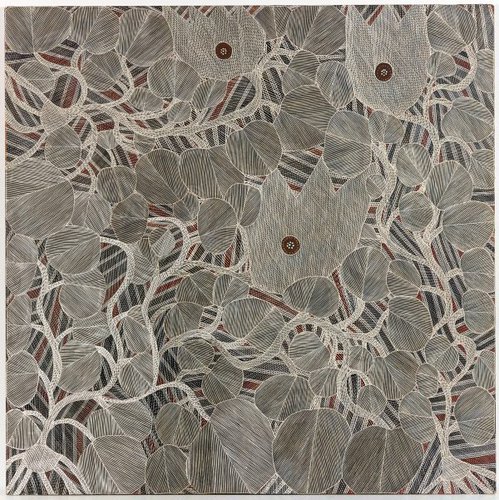Title
Garrimala
2015
Artist
-
Details
- Place where the work was made
-
Yirrkala
→
North-east Arnhem Land
→
Northern Territory
→
Australia
- Cultural origin
- Dhalwangu/Arnhem region
- Date
- 2015
- Media category
- Materials used
- etching on paper
- Edition
- 21/30
- Dimensions
- 40.0 x 40.0 cm
- Signature & date
Signed l.r. corner, pencil "Malaluba". Not dated.
- Credit
- Purchased with funds provided by the Aboriginal Art Collection Benefactors 2015
- Location
- Not on display
- Accession number
- 256.2015
- Copyright
- © Malaluba Gumana, courtesy Buku-Larrnggay Mulka Centre, Yirrkala.
- Artist information
-
Malaluba Gumana
Works in the collection
- Share
-
-
About
'Garrimala' 2015 refers to a billabong close to Malaluba Gumana’s homeland of Gängan. Dominating the work are realistic representations of dhatam, the waterlily plant. Delicate miny’tji (clan designs) are set behind these graceful forms to represent djari (rainbows) and the power of lightning infused within them.
Garrimala is particularly imporant to Gumana’s mother’s Galpu clan and is connected to Wititj (an olive python commonly referred to as the rainbow serpent). Djayku (the Javanese filesnake) is a companion and possible alternate incarnation of Wititj and lives amongst the dhatam, causing ripples or rainbows on the surface of the water. The sun shining on the scales of Wititj also give the appearance of rainbows. Wititj is associated with the beginning of the wet season when square shaped clouds begin to form and lightning strikes are common.
Art centre documentation states:
This print represents Garrimala, a billabong near the artist’s residence; the Dhal’wangu clan homeland at Gangan.Wititj is the rainbow serpent (olive python) that traveled through Galpu clan lands and on further, during the days of early times called Wangarr. Djaykung the Japanese file snake is a companion living in amongst the Dhatham, or waterlillies, causing ripples and rainbows (Djari) on the surface of the water.
The Galpu clan Miny’tji (sacred clan design) behind the lillies represents Djari (rainbows) and the power of the lightning within them. The sun shining against the scales of the snake form a prism of light like a rainbow. It also refers to the power of the storm created by Wititj. The diagonal lines represent trees that have been knocked down as Wititj moves from place to place.
Says the artist “This is Garrimala, my ngandi wanga (my mother’s place). It is a Galpu clan design. Only Dhatham is all I can paint, I’m not allowed to make the deep story miny’tji – this is only for the men. I’m not allowed to paint this because this is important miny’tji”
© Buku Larrnggay Mulka Art Centre
-
Places
Where the work was made
Yirrkala
-
Exhibition history
Shown in 1 exhibition
Revolution: new work celebrating 20 years of printmaking at Yirrkala Print Space, Nomad Art, Parap, 06 Aug 2015–29 Aug 2015




